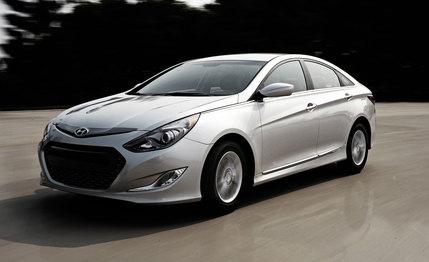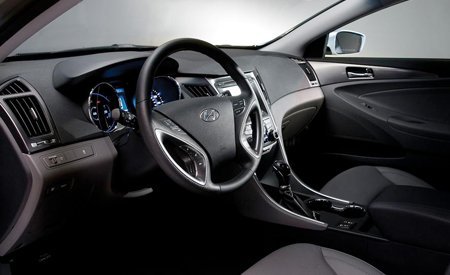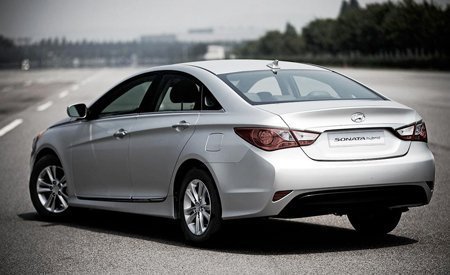
 Prototype Drive
Prototype Drive
It’s time to revoke Hyundai’s underdog status and start expecting as much from the South Korean automaker as we would from any other mainstream brand. Case in point: the new Sonata hybrid. Hyundai has created its own unique hybrid system rather than licensing technology from Toyota (as Nissan does) or forming a development partnership (as did BMW, Chrysler, GM, and Mercedes-Benz for the two-mode parallel system).
The surging Korean automaker has opted for state-of-the-art lithium-polymer batteries. Co-developed with LG Chem, these units are lighter and more compact than the lithium-ion or nickel-metal hydride batteries found in other hybrids. The Sonata’s 1.4-kilowatt-hour battery pack weighs 96 pounds and sits behind the rear seat, reducing trunk space to 11 cubic feet from 16. All told, the hybrid powertrain adds a claimed 260 pounds to the Sonata versus about 400 for the one in the Ford Fusion.
The heart of this hybrid system, dubbed Blue Drive, is a 40-hp electric motor that sits between the engine and the transmission in place of a torque converter. An electronically actuated hydraulic clutch engages and disengages the engine from the motor and conventional six-speed automatic transmission. A combination starter/alternator handles the stop/start functions of the gasoline engine.


Hyundai says this approach reduces its costs by avoiding the two large motors and planetary CVT used in Ford and Toyota hybrids. Furthermore, Hyundai contends that drivers prefer the stepped gears of an automatic transmission to a gearless CVT and that the system is easier to apply to other existing powertrains.
With an estimated 37-mpg rating on the EPA city cycle, the Sonata doesn’t topple the leader of fuel-sipping family sedans, Ford’s 41-mpg Fusion hybrid. But unlike most other hybrids, the Sonata does better on the highway than in the city, running a claimed 40 mpg. On electric-only power, the Sonata can cruise at speeds up to 62 mph, but any meaningful acceleration requires calling upon the 2.4-liter inline-four. Otherwise identical to the Sonata’s gas engine, it runs on the Atkinson cycle, which boosts efficiency but makes 29 fewer horses, at 169.


On our test drive at Hyundai’s Namyang R&D Center, we found that the Sonata hybrid offers a seamless experience with one exception: The transmission in the prototype we sampled got jerky during a passing maneuver because the engine restart coincided with a downshift. Hyundai estimates a 0-to-60-mph time of 9.2 seconds, slower than a standard gas-driven Sonata (7.8 seconds) and behind the Camry and Fusion hybrids we’ve tested.
When it arrives by the end of the year, it’s likely that the hybrid Sonata’s sticker will undercut the Fusion’s $28,825 starting price. So far, all the pieces we’ve seen—technology, performance, price—suggest that it will be a first-rate effort. Just what we expect from Hyundai.